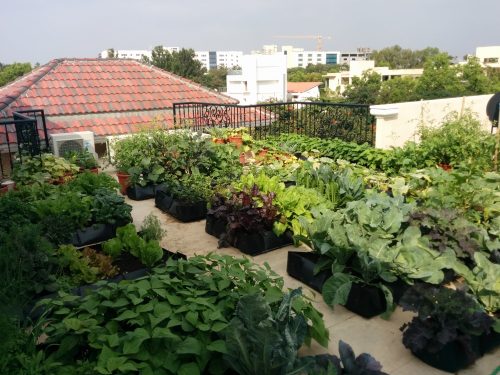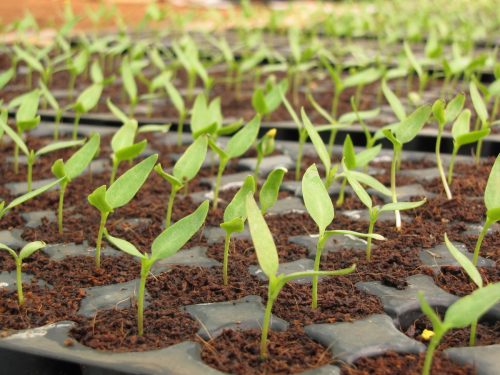TBI Blogs: Everything You Ever Wanted to Know About Starting a Vegetable Garden in Your Own Home
Turn your terrace or balcony into an urban vegetable garden with this comprehensive guide about gardening in the city.

Turn your terrace or balcony into an urban vegetable garden with this comprehensive guide about gardening in the city.
Creating something always brings joy and a sense of accomplishment. It can be a piece of art, a tasty dish or even a garden. A vegetable garden, to be specific. Contrary to popular belief, one doesn’t need a green thumb to grow an organic vegetable garden.
All it takes to make a successful vegetable garden is some enthusiasm, some planning and a whole lot of you!

Image Source: GeekGardener
First, decide which vegetables you want to grow
The first step in planning a vegetable garden is to decide what to plant in your garden. It is always best to start small and work your way up as you gain knowledge. Taking a look at what vegetables your family consumes is a good starting point.
Decide between short-term vegetables and long-term vegetables
There are vegetables that can be harvested in 1-1.5 months, and then there are those that take 2-3 months. For a beginner, the recommendation is to start with vegetables that are short-term. These include:
- Spinach
- Methi
- Coriander
- Mint
- Lettuce
- Radish
Some long-term vegetables are:
- Tomatoes
- Brinjal
- Capsicum
- Chilli
- Cauliflower
- Cabbage
Zero in on a location for the garden
Sunlight
Most vegetables need 4-6 hours of direct sunlight. Vegetables grow well in locations that receive 6+ hours of light. For a location that receives 4 hours or less, salad greens can be an option. In cities, container gardening is the easiest way to start.
With containers, the garden can be set up in the balconies or rooftops. South and west facing balconies get the most sun, followed by east facing. Since north facing balconies get sunlight only during summer months, salads and leafy greens can be planted here.
Fruiting plants such as tomatoes and eggplants can be planted in south or west facing balconies.
Water
Choose a location for your garden that is close to a water source. This makes it easy to water the plants daily. Properly watering the plants can make all the difference in the growing process.
Soil
When growing plants on the ground, choose a place with good soil that is free from debris or stones. This does not apply when growing plants in containers as the soil mix is decided by us.
Size of container
The size of the garden can be based on the number of different vegetables one is thinking of growing.
For leafy greens and salads, one square foot, or a container that is 12” diameter and 10-12” height, is recommended. This can grow about 3-4 plants.
In terms of volume, the container should be able to hold 8-10 liters of potting medium. If you are really out of space, just about any container would do as shown in the image below.

For bigger plants such as tomatoes, chilies and brinjals, a single plant may be planted in a pot/container that is 12” in diameter and 12” in height. The volume of potting mix required is 15-20 liters.
Ten square feet is adequate space for a garden with few different crops. That said, there is no minimum space for a garden.
Plan a budget for the garden
Budgets for vegetable gardens can either have close to zero investment or, alternatively, can go into several thousands of rupees. For a container filled with potting mix, it can cost anywhere between Rs.200 to Rs. 400 based on the quality of the pot and its size.
Procure the necessary materials needed to set up a garden
Containers
One of the most popular choices for containers is Terracotta, which is very eco-friendly. If weight is an issue, these can be replaced with a plastic or wooden planter box.
Keep drainage in mind while selecting a container. The container should have at least one drainage hole to easily drain out the water.
Seeds / Seedlings
There are two types of seeds: open-pollinated and hybrid. The open pollinated seeds give rise to plants from which you can save seeds for the next crop, whereas hybrid plant’s seeds cannot be saved as they will not be the same as the parent plant’s characteristics.
Potting Mix
The potting mix used for plants should provide support and required nutrition. The ideal mix for potting can be made by mixing equal proportions (1:1) of cocopeat and compost.
Fertilizers
There are several types of fertilizers, which broadly fall into one of two categories: organic and synthetic. Vermicompost, manure and kitchen waste compost are popular organic fertilizers.
Garden Setup Procedure

Seed Sowing
The process of getting the seed to sprout is called ‘germination.’ For this, seeds need to be sown at the right depth. The thumb rule is, the seeds need to be buried twice as deep as they are wide. Seeds can be sown in the potting mix described in the previous steps. As soon as the seeds germinate, they need to be exposed to sunlight, failing which the seeds will become tall & lanky. What seeds to sow also depends on the location and the time of the year.
For more information on seasonal sowing calendar, refer to this sowing chart
Transplanting
Some plants can directly be sown in their final growing area, whereas certain plants have to be transplanted from one location to another. This is done for various reasons. For larger areas, it is easier to grow seedlings in one area and transplant healthy seedlings over a larger area when they are ready.
Staking / Pruning
Staking is done to hold the plant from falling by supporting it with a pole or a stick. For taller plants, a twine or a long stick can be used.
For climbers, a pandal type of a support can be provided so that they can spread and sprawl over them.

Maintenance of the garden
Watering
Watering is essential for plants to grow and has to be done every day, preferably during the mornings. Water the plants thoroughly till the water drains from the bottom of the container.Properly watering the plants can increase their chance of success.
Fertilizing
As plants grow, they feed on the nutrients contained in the soil, which results in depletion of nutrients. Apply a handful of compost or manure every 10-15 days to the container to keep the soil healthy.
Pests
Everyone loves a nice vegetable garden and so do the pests. Daily scouting in the garden, looking for holes/cuts in the leaves can help identifying pests. Most common pests are Aphids, mealy bugs, mites and worms.
Most pests can be controlled by using Neem oil spray. Mix 10 ml of Neem oil with 1 liter of water and to this, add 5 ml of liquid dish-washing soap and mix well. This spray has to be applied weekly only, on both sides of the leaves.
Equipped with this knowledge, starting a vegetable garden and caring for it becomes easy.
Happy Gardening!
For more tips and tricks on gardening, click here.
Like this story? Or have something to share? Write to us:[email protected], or connect with us on Facebook and Twitter (@thebetterindia).
If you found our stories insightful, informative, or even just enjoyable, we invite you to consider making a voluntary payment to support the work we do at The Better India. Your contribution helps us continue producing quality content that educates, inspires, and drives positive change.
Choose one of the payment options below for your contribution-
By paying for the stories you value, you directly contribute to sustaining our efforts focused on making a difference in the world. Together, let’s ensure that impactful stories continue to be told and shared, enriching lives and communities alike.
Thank you for your support. Here are some frequently asked questions you might find helpful to know why you are contributing?


This story made me
-
97
-
121
-
89
-
167













